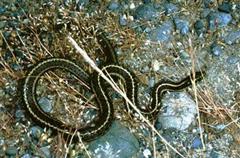Garter Snake - Canadian
Scientific Name: Thamnophis radix haydeni
Sun, 6th July, 2025 - 1:34 am GMT
Sponsor Ads:

Alternative Name
Scientific Name: Thamnophis radix haydeniBasic Info
The Plains Garter Snake has a background scale color of black or brown on which are visible black spots arranged in two rows. Three stripes run the length of the Plains Garter Snake: the dorsal stripe is usually orange but may be yellow or may even change from one color to the other. The other two stripes are whitish or cream colored, as is the belly of the Plains Garter Snake, which is sometimes bluish in color. Between the belly and the two lateral stripes, is another row of black spots, and the head of the Plains Garter Snake is black or brown and may have two yellow eye spots. Generally, this variety of Garter Snake grows to be 14 to 43 inches in length, and the body has a "thick" appearance. These snakes are not venomous.
Health
Breeding The Plains Garter Snake breeds in the spring, and unlike many other snakes does not lay eggs but gives birth to live young. Anywhere from 10 to 70 young snakes five to eight inches in length are born in the fall or in late summer.Habitat
Found in the drier grasslands of northern North America,Behavior
The Plains Garter Snake is a calmer version of the typical Eastern Garter Snake. In the wild, this Garter Snake makes a great pest-controller, and makes a fine pet. Found in the drier grasslands of northern North America, this snake is also known as the Canadian Plains Garter Snake. A diurnal hunter, the Plains Garter Snake must regulate its own body temperature, and spends it days in sun-basking and hunting food. Very docile, these snakes are not as aggressive as other Garter Snakes and will not bite at perceived threat but rather emit a foul odor from their scent glands. If the Plains Garter Snake feels trapped, he will curl into a ball, raise his tail, and wag it back and forth. Generally, these Garter Snakes take refuge in other animals' burrows or under rocks or logs. They hibernate for at least six months of the year during the cold season. Plains Garter Snakes are often found hibernating with other species of snakes and sometimes use people's basements as hibernacula. Very small or young Plains Garter Snakes will even use old ant mounds for this purpose. In captivity, hibernation should be effected by temperature control and ample food and space must be provided. It has been reported that males may become aggressive towards each other during mating season, and for this reason should be housed in different enclosures during this time. The Plains Garter Snake may be kept as a pet because it has a more docile nature than other Garter Snakes. In the wild, it is not particularly endangered and readily adapts to a variety of habitats.Origin
North AmericaHistory
N/ACommon Foods
The usual food of the Plains Garter Snake includes frogs, eggs, mice, fish, and salamanders, though earthworms are not unusual. Any small animal is fair game for the Plains Garter Snake, and even carrion is eaten.Sponsor Ads:
A narrow mind has a broad tongue. -- Unknown
Garter Snake - Canadian
Coded by: BGID® | ALL RIGHTS RESERVED Copyright © 2000-2025
Disclaimer | Privacy | Report Errors / Contact | Credits

 Preparing For China. China is growing their military. China Military Technology - can it keep up with the US?
Preparing For China. China is growing their military. China Military Technology - can it keep up with the US?  versus
versus 

 versus
versus 
 This Thread is about the North Korean Military itself - the kind of army, navy, and air force they have.
This Thread is about the North Korean Military itself - the kind of army, navy, and air force they have. 
 versus
versus 
 versus
versus  versus
versus